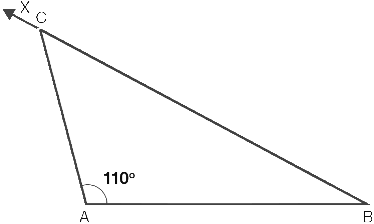NCERT Solutions for Class 7 Maths Chapter 10 Practical Geometry
1. Draw a line, say AB, take a point C outside it. Through C, draw a line parallel to AB using ruler and compasses only.
Answer:

Steps for construction:
1. Draw a line AB.
2. Take any point Q on AB and a point P outside AB and join PQ.
3. With Q as the centre and any radius, draw an arc to cut AB at E and PQ at F.
4. With P as the centre and the same radius, draw an arc IJ to cut QP at G.
5. Place the pointed tip of the compass at E and adjust the opening so that the pencil tip is at F.
6. With the same opening as in step 5 and with G as the centre, draw an arc cutting the arc IJ at H.
7. Now, join PH to draw a line CD.
2. Draw a line L. Draw a perpendicular to L at any point on L. On this perpendicular, choose a point X, 4 cm away from l. Through X, draw a line m parallel to L.
Answer:

Steps for construction:
1. Draw a line L.
2. Take any point P on line L.
3. At point P, draw a perpendicular line N.
4. Place the pointed tip of the compass at P and adjust the compass up to length of 4 cm, draw an arc to cut this perpendicular at point X.
5. At point X, again draw a perpendicular line M.
3. Let L be a line and P be a point not on L. Through P, draw a line m parallel to L. Now join P to any point Q on L. Choose any other point R on m. Through R, draw a line parallel to PQ. Let this meet L at S. What shape do the two sets of parallel lines enclose?
Answer:

Steps for construction:
1. Draw a line L.
2. Take any point Q on L and a point P outside L and join PQ.
3. Make sure that angles at point P and point Q are equal, i.e., ∠Q = ∠P
4. At point P, extend the line to get line M which is parallel L.
5. Then take any point R on line M.
6. At point R, draw an angle such that ∠P = ∠R.
7. At point R, extend the line which intersects line L at S and draw a line RS.
4. Construct ΔXYZ in which XY = 4.5 cm, YZ = 5 cm and ZX = 6 cm.
Answer:

Steps of construction:
1. Draw a line segment YZ = 5 cm.
2. With Z as a centre and radius 6 cm, draw an arc.
3. With Y as a centre and radius 4.5 cm, draw another arc, cutting the previous arc at X.
4. Join XY and XZ.
Then, ΔXYZ is the required triangle.
5. Construct an equilateral triangle of side 5.5 cm.
Answer:

Steps of construction:
1. Draw a line segment AB = 5.5 cm.
2. With A as a centre and radius 5.5 cm, draw an arc.
3. With B as a centre and radius 5.5 cm, draw another arc, cutting the previous arc at C.
4. Join CA and CB.
Then, ΔABC is the required equilateral triangle.
6. Draw ΔPQR with PQ = 4 cm, QR = 3.5 cm and PR = 4 cm. What type of triangle is this?
Answer:

Steps of construction:
1. Draw a line segment QR = 3.5 cm.
2. With Q as a centre and radius 4 cm, draw an arc.
3. With R as a centre and radius 4 cm, draw another arc, cutting the previous arc at P.
4. Join PQ and PR.
Then, ΔPQR is the required isosceles triangle.
7. Construct ΔABC, such that AB = 2.5 cm, BC = 6 cm and AC = 6.5 cm. Measure ∠B.
Answer:

Steps of construction:
1. Draw a line segment BC = 6 cm.
2. With B as a centre and radius 2.5 cm, draw an arc.
3. With C as a centre and radius 6.5 cm, draw another arc, cutting the previous arc at A.
4. Join AB and AC.
Then, ΔABC is the required triangle.
5. When we will measure the angle B of triangle by a protractor, the angle is equal to ∠B = 90o
8. Construct ΔDEF such that DE = 5 cm, DF = 3 cm and m∠EDF = 90o.
Answer:

Steps of construction:
1. Draw a line segment DF = 3 cm.
2. At point D, draw a ray DX to making an angle of 90o, i.e., ∠XDF = 90o.
3. Along DX, set off DE = 5cm.
4. Join EF.
Then, ΔEDF is the required right-angled triangle.
9. Construct an isosceles triangle in which the lengths of each of its equal sides is 6.5 cm and the angle between them is 110o.
Answer:

Steps of construction:
1. Draw a line segment AB = 6.5 cm.
2. At point A, draw a ray AX to making an angle of 110o, i.e., ∠XAB = 110o.
3. Along AX, set off AC = 6.5cm.
4. Join CB.
Then, ΔABC is the required isosceles triangle.
10. Construct ΔABC with BC = 7.5 cm, AC = 5 cm and m∠C = 60°.
Answer:

Steps of construction:
1. Draw a line segment BC = 7.5 cm.
2. At point C, draw a ray CX to making an angle of 60o, i.e., ∠XCB = 60o.
3. Along CX, set off AC = 5cm.
4. Join AB.
Then, ΔABC is the required triangle.